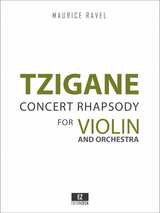
REPRINT SERIES
L'enfant et les sortilèges: Fantaisie lyrique en deux parties (The Child and the Spells: A Lyric Fantasy in Two Parts) is an opera in one act, with music by Maurice Ravel to a libretto by Colette. It is Ravel's second opera, his first being L'heure espagnole.
SYNOPSIS
Place: An old-fashioned Normandy country home
Part 1
This is the story of a rude child who is reprimanded by the objects in his room which he has been destroying. After being scolded by his mother in the beginning of the opera, the child throws a tantrum destroying the room around him. He is then surprised to find that the unhappy objects in his room come to life. The furniture and decorations begin to talk; even his homework takes shape as it becomes an old man and a chorus of numbers.
Part 2
The bedroom becomes a garden filled with singing animals and plants which have been tortured by the child as well. The child attempts to make friends with the animals and plants, but they shun him because of the injuries he did to them earlier before they could talk. They leave him aside, and in his loneliness, he eventually cries out "Maman". At this, the animals turn on him and attack him, but the animals wind up jostling among each other as the child is tossed aside. At the culmination, a squirrel is hurt, which causes the other animals to stop fighting. The child bandages the squirrel, then collapses exhausted. The animals have a change of heart toward the child, and decide to try to help him home. They carry the child back to his house, and sing in praise of the child. The opera ends with the child singing "Maman", as he greets his mother, in the very last measure of the score.
MUSIC
The opera calls for a large orchestra, a mixed chorus of adults, a chorus of children and eight soloists, most of whom individually play a number of characters. The scale of the cast and fantastic setting make the opera often difficult to stage, which helps to explain why the work is not performed often. Ravel uses various subtle leitmotifs throughout the work, and there is considerable virtuosity in the instrumental writing. Yet the orchestra plays mostly secondary role to the sung melodies, Ravel explaining that he was following the style of Gershwin and American operettas of the time.
- Difficulty:
- Advanced
- Instrumentation:
- Vocal soli, Choruses (SATB, Children) and Orchestra
- .:
- 2 flutes, piccolo, 2 Oboes, English horn, piccolo clarinet (E♭), 2 clarinets, bass clarinet, 2 bassoons, contrabassoon
- .:
- 4 horns (F), 3 trumpets (C), 3 trombooes, tuba timpani, piccolo timpani (D), triangle, tambourine, cymbals, bass drum, tam-tam, whip,
- .:
- ratchet, cheese grater, woodblock, wind machine ("eoliphone"), crotales, slide whistle ("flûte á coulisse"), xylophone, celesta, harp, piano (or luthéal), strings
- Duration:
- 45 min.
- Set of Parts:
- Includes strings count 5.5.4.4.3
- Product Type:
- REPRINT SERIES
- ISMN:
- 979-0-53007-983-6






